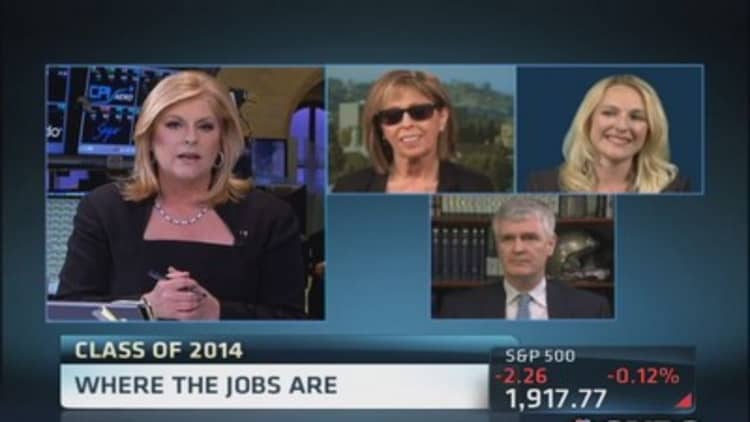The employment picture is clearly improving, but one trend is also clear—Americans lack the skills to fill all the job openings.
Monthly job growth of 200,000 or more, a four-week average in unemployment claims on par with 2007 levels and a big jump in job openings all point to improvement.
The latest anecdote on the jobs market was Tuesday's release of the Job Openings and Labor Turnover survey. The survey showed that there were a surprising 4.5 million job openings in April, a nearly 7 percent increase from the March level of 4.2 million.
At the same time, the ratio of unemployed job seekers compared to job openings fell to 2.19 in April, off from the 2.51 in March and the lowest reading since June 2008, according to Barclays.
The job openings rate increased 0.2 percent, to 3.1 percent. Other details in the April report were not as positive.
Read More
"I would say the JOLTs data is showing the signs of a grinding recovery," said Joseph LaVorgna, chief U.S. economist at Deutsche Bank.
The number of hires was nearly unchanged and the hiring rate stayed at 3.4 percent, while the number of quits rose by 0.5 percent, but the quits rate held at 1.88 percent, according to the JOLT survey. The number of quits tends to rise when the labor market improves.
Some 2.47 million people quit their jobs in April, up from 2.46 million the prior month.

Layoffs increased 0.8 percent in April, and the layoffs rate held at 1.2 percent for a fifth month. The trade, transportation and utilities sector showed the biggest increase with 93,000 job openings. Professional and business services increased by 66,000. Retail job openings increased by 65,000. Government job openings were barely changed.
"If we still didn't have this large supply of surplus labor that doesn't have the required skill set, the JOLTs data would say something much more powerful," said Ward McCarthy, chief financial economist at Jefferies.
That report is particularly important to Fed Chair Janet Yellen, but it is unlikely to slow or speed up the Fed's easing policies, economists say.
"We are seeing the hiring improve this year. That to me is pretty encouraging, but I think the Fed is going to stay very accomodative," LaVorgna said.
Yellen has made clear that she is also concerned about the long-term unemployed and the quality of the job gains. The labor participation rate also remains stubbornly low, unchanged at 62.8 percent in May.
"We're back to where we've shown improvement in the labor market, but we still have a long way to go to get back to normal," McCarthy said. "We still have an unemployment rate that was the peak of the prior recession. The 6.3 percent unemployment rate is nothing to write home about. The troubling thing is the number of unemployed people who have been unemployed for a long time is really high by historic standards."
Read MoreWhere have all the jobs gone?
The May employment report showed an increase of 217,000 jobs, but the number of individuals in the long-term unemployed category held steady at 3.4 million, or 34.6 percent of the unemployed.
"This is very encouraging that there are this many job openings, but it's less encouraging that there aren't people out there to fill those job openings," he said.
McCarthy said the long-term unemployment is an issue since the longer workers are unemployed the less up-to-date their skills are.
The Fed's Beige Book on the economy, released last week, also showed the same issue of underskilled workers. It noted that hiring activity was generally stronger, but companies in several regions reported difficulty finding qualified candidates for highly skilled and upper management positions.
McCarthy said the job market could be a year away from being more "normal." A big positive is that the economy has now recovered all of the jobs lost in the recession.
The 8.7 million jobs were restored as of the May report.
"It's significant because our work has found if you go back to the previous peak, job growth tends to accelerate," said LaVorgna, adding that companies reach the point where they can no longer squeeze more man hours out of the work force.
He said he expects the pace of job creation to accelerate to 225,000 to 240,000 in coming months, and particularly encouraging is that the four-week average for new unemployment claims is running at 310,250, the lowest level since June 2007.
Read More
The National Federation of Independent Business said its Small Business Optimism Index rose 1.4 points, to 96.6 last month. This was the highest reading since September 2007.
LaVorgna said it was also a positive for employment that the report showed small businesses intend to increase workers' pay.
—By CNBC's Patti Domm. Follow her on Twitter @pattidomm.


